Amir (not his real name) is a 2 year old active, healthy, and cheerful boy. However, his parents are worried as he seems unable to hear very well. Intially, his parents were not suspicious as he was able to turn to noise and was interactive while playing games and watching television. Currently, they are having difficulty teaching Amir words and need to raise their voice to call him. Even worse, he is still unable to say ‘mama’ or ‘papa’ yet.
This is one of the scenario which may be encountered in a family clinic. In some cases, some may present at Amir’s age of 2 years old. Sad for others, hearing loss may be presented at a much older age. About 3 in 1000 children faced significant hearing loss.
Fact: A person need to be able to hear sound first, then only that person can speak.
Therefore, they may come to the clinic presenting with a speech delay rather than hearing loss.
How can I know if a child has hearing loss?
Clues in a child include:
- Does not appear to hear.
- Does not make any effort to listen.
- Does not respond to common cues: name, common items, or “no”.
- Does not speak at what is expected of his/her age. Rough guide to speech developmental milestone in a child:Single word by 1 year of age, 2 words sentence by 2 years of age and 3 words sentence by 3 years of age. We also expect increasing number of words as months pass by.
There are many causes to childhood hearing loss. Among the common ones include:
- Infection acquired by the child before delivery (during mother’s pregnancy) or after delivery;
- Medications received before and after delivery;
- Severe neonatal jaundice;
- Genetically inherited hearing loss.
However, it is sometimes difficult to find the exact cause because the insult to the hearing level is not seen immediately, more to a retrospective analysis of most likely causes. Clinicians must be aware of this and refer to the ENT (Ear, nose and throat) team for further assessment. The longer the delay, it will become more difficult for these children to adjust socially and to interact well with other children in school and later in adulthood.
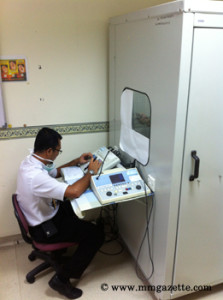 In ENT, general assessment will be done by the ENT doctor. We will look out for any specific facial or body
In ENT, general assessment will be done by the ENT doctor. We will look out for any specific facial or body
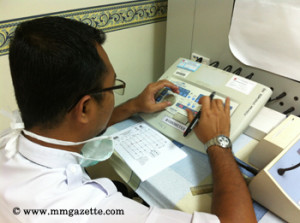
The various level of sound frequncy & intensity will be altered via the device. The tester will then note in the graph the lowest sound intensity heard by the subject
features suggestive of inherited disorders. We will also note whether it is just an isolated speech delay or a global developmental delay- where the child is not up to his age in other aspects such as walking, proper use of fingers, eye coordination and social skills.
Simple basic hearing test by introducing noise from behind (distraction test) will be done, depending on the child’s age. I personally will examine the ears of the child as the last step, as the child may cry with the otoscope in his/her ear canals.
The Audiologist will do the main task of confirming the hearing loss.
How can they test the hearing?
The Audiologist will assess the age of the child and the most suitable test for the patient. Some tests need the child to follow instructions and different tests are available depending on how cooperative they are.
Children who are able to follow instructions, usually above 6 years old, may undergo Pure Tone Audiometry. This is the usual test done for adults. The child will be sitted in a soundproof room with headphones, where the sound will be introduced (images 1,2 & 3). Variable frequencies & loudness (decibels) will be plotted on the graph (image 4). The test is accurate if the child is cooperative and able to follow instructions well.
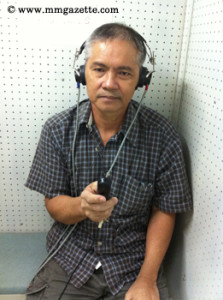
The same test for adult can be done in children, provided they are cooperative. Sound will be introduced through the headphones and the subject presses the button each time he is able to hear the test noise
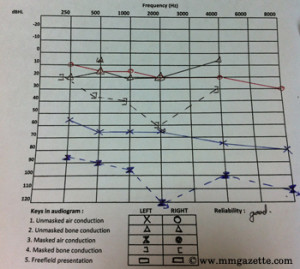
The audiogram showing the plotted points done during the test and will indicate the degree of hearing loss
What if my child is of younger age or cannot perform the above test?
Your child may undergo a similar test, with slight modification. Similar headphone will also be used. Instead of touching buttons on hearing the noise, the child will be given toys to play. They will then be instructed to perform tasks with the toys given when they hear the noise. The audiologists are well trained to make the test as enjoyable and fun activity as possible for the child rather than a chore. This is called play audiometry.
If your child does not want to use the headphone or of a younger age group, large speakers will be placed on their sides. Images will appear on screen if the child turns to the noise correctly. This modification is called visual reinforcement audiometry.
Can they diagnose whether a newborn child has hearing loss?
In developed countries, all newborn will undergo a hearing test using otoascoustic emission (OAE). This is comfortable for the child and only takes a few minutes (Image 5). In Malaysia, there is still a shortage of Audiologist. Therefore, most hospitals will only do this test if the child has high risk of acquiring hearing loss with the risk factors I have mentioned earlier.
If this test is repeatedly inconclusive, a more specific test will be done. Auditory Brainstem Response (ABR) or its variation Auditory Steady State Response (ASSR) will be conducted for confirmation. The child will need to be sedated and test will run for roughly 15 minutes (image 6 & 7).
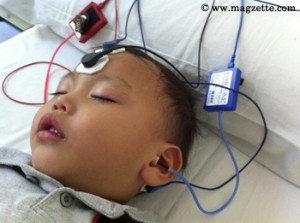
A sedated child undergoing ASSR hearing test. He needs to be fully relaxed for this test
To answer the topic, what can I do to help my child with hearing loss?
We need to be aware that a child may have hearing loss as the symptoms are subtle. You can help the child with suspected hearing loss or speech delay by seeing a doctor for assessment. The doctor should then refer the child to the ENT team for full assessment with the Audiologist. Paeditatricians should also be aware of high risk cases and make the necessary referral if needed.
Early detection will help in early hearing intervention and speech development, thus hopefully the child will blend in socially without being labelled as handicapped. I hope to discuss on intervention of children with hearing loss in my future articles.
(Acknowledgement: I would like to thank the patients, parents and staffs again for allowing the use of their pictures for the benefit of public health education)
Dr Ahmad Nordin is an ENT surgeon currently working in Sabah. Find out more about him on The Team page.
[This article belongs to The Malaysian Medical Gazette. Any republication (online or offline) without written permission from The Malaysian Medical Gazette is prohibited.]
Reference:
- Paediatric Protocols For Malaysian Hospitals 3rd Edition Hussain Imam Hj Muhammad Ismail, Ng Hoong Phak, Terrence Thomas
- Guidelines For High Risk Neonatal Hearing Screening Ministry of Health Malaysia August 2009
